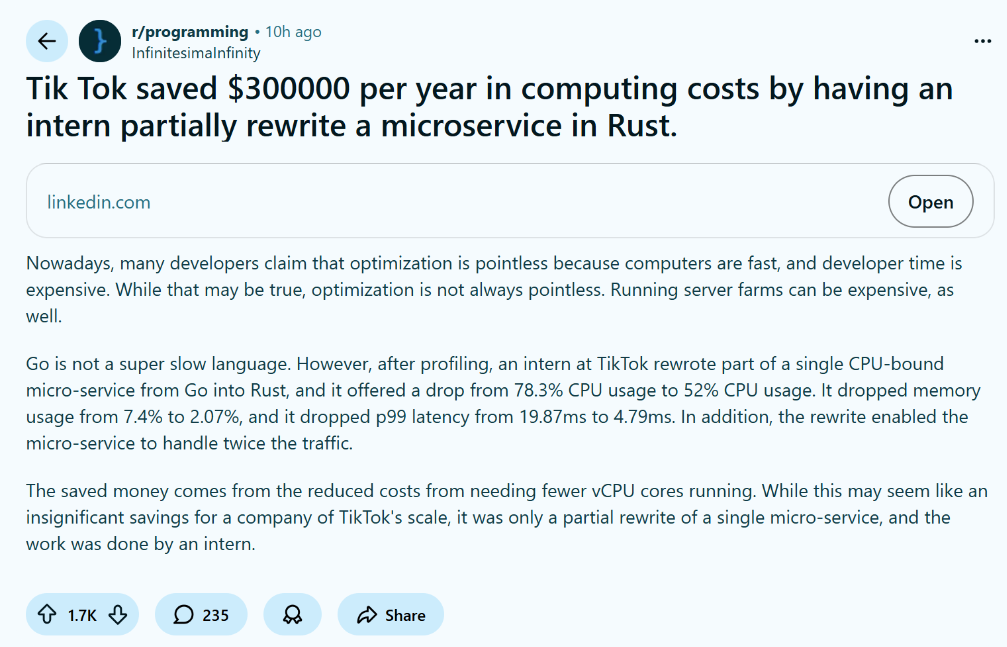Save $300K a Year! Intern Uses Rust to Cut TikTok Costs Fast — Developers Say It’d Only Save $300 at a Small Company

Rust Rewrite Case Study — How a TikTok Intern Saved $300,000/Year
Organized by: Zheng Liyuan
Produced by: CSDN (ID: CSDNnews)
---
Introduction
In developer circles, you may hear:
> "Don’t bother optimizing — computers are fast enough; don’t waste development time for tiny gains."
There’s some truth here — but it’s far from the whole story. In certain high-scale situations, server bills can be huge.
Recently, TikTok intern Xiaoyun Wu shared a striking example: by rewriting part of a core payment service from Go to Rust, he achieved:
- 2× performance improvement
- 76% lower latency
- One-third CPU usage reduction
- ~$300,000/year savings (~¥2.13M) in cloud costs
For a giant like TikTok, $300K might seem modest — but this was just one module, rewritten by an intern.


---
Surgical Refactoring — Rewriting Only the Pain Points in Rust
Wu’s blog explains: TikTok LIVE’s payment service was a long-running Go system — stable, concise, great for microservices.
But as TikTok LIVE exploded, symptoms appeared:
- High CPU usage
- Frequent stability alerts
- Continuous scaling to maintain quality
- Soaring cloud costs
After profiling, the real bottleneck was found:
- High-frequency APIs for user balance checks and statistics retrieval
- Computation-heavy & traffic-heavy, dominating CPU time
- Go-level optimizations maxed out — the language hit its ceiling
Wu followed three precise steps:
---
1. Precise Rewrite — Rust as a Surgical Tool
Rather than rewriting everything, only CPU-intensive endpoints were converted to Rust. All other logic remained in Go.
Why Rust?
- Near C-level performance
- Memory safety without garbage collection
- Ideal for high-concurrency, intense computation
This polyglot architecture preserved Go’s fast development while injecting Rust’s raw speed where it mattered.
> Takeaway: Rust tackles bottlenecks; Go holds the fort.
---
2. Correctness Verification — Fast ≠ Accurate
Performance wins are useless without correct results.
Approach: Run Rust endpoints in shadow mode alongside the production Go service:
- Feed Rust a live copy of traffic
- Compare outputs in verification pipeline
- After weeks with 100% data match, move to load testing
---
3. Load Testing — Push the Limits
Two identical production clusters were built:
- One running Go endpoints
- One running Rust endpoints
Testing used 16,000 anonymized real user IDs, increasing load gradually to max capacity while monitoring:
- QPS
- Latency
- CPU usage
- Memory usage

---
Results — Double Throughput, Halved Costs

- Endpoint A — 85K QPS → 150K QPS (~1.8× gain)
- Endpoint B — 105K QPS → 210K QPS (2× gain)
Impact:
- Each machine can now handle more traffic
- Directly retired ~400 vCPU cores
- Annual savings ~$300K in cloud costs
---
Key Insight — Right Tool for the Right Job
Wu cautions:
> "This is not Rust vs Go. Rust shines in a few bottleneck services; Go’s dev efficiency still wins for 95% of microservices."

---
From NUS to TikTok — An Intern’s Growth Path
Wu is a Computer Science major (minor in Statistics) at National University of Singapore, researching programming languages & parallel computing.
Track Record:
- TikTok Global LIVE Wallet Team (Dec 2024 – Aug 2025)
- Rust rewrite for payment APIs → $300K savings
- Built AI-driven Oncall incident analyzer (LLMs + Golang + vector DB) to cut operational workload
- TikTok LIVE Money Platform (May – Aug 2024)
- Front-end build optimization
- Doubled packaging speed
- Cut CI/CD time 15min → 10min via Rspack migration
- Volunteer Welfare Org Computing Dept (2023)
- Ruby on Rails → Go migration
- Backend response speed ↑ 5×
This blend of academic rigor + hands-on projects prepared him to optimize large-scale distributed systems like TikTok.

---
Developer Reactions — "Is Optimization Worth It?"
Wu’s blog sparked Reddit debates — the headline "Intern saves TikTok $300K using Rust" became clickbait fodder.

Views diverged:
- Optimization still matters — scaling multiplies savings
- Big-company scale only — startups won’t save enough to justify engineering cost
Common takeaway:
Optimization must be timely, targeted, measurable.
> At scale, server cost can surpass people cost — performance becomes a survival issue.
---
Broader Context — Efficiency Beyond Code
For small teams or creators, similar principles apply to content workflows:
Platforms like AiToEarn官网 use AI to generate, publish, and monetize content across:
Douyin, Kwai, WeChat, Bilibili, Xiaohongshu, Facebook, Instagram, LinkedIn, Threads, YouTube, Pinterest, and X.
Strategic automation — whether in code or content — delivers outsized returns when applied at the right time.
---
Summary Lessons for Engineers
- Profile first — know your real bottlenecks
- Targeted rewrites beat wholesale migration
- Verify correctness before scale tests
- Account for integration costs in multi-language stacks
- Optimization payoff grows with scale
---
References
- Rust Rewrite Case Study — wxiaoyun.com
- Reddit Discussion: TikTok Saved $300,000/year by Rewriting in Rust
---
Would you like me to add a comparison table between Go and Rust for this case to visually highlight why Rust made a difference here? That could make the rewrite even more reader-friendly.




